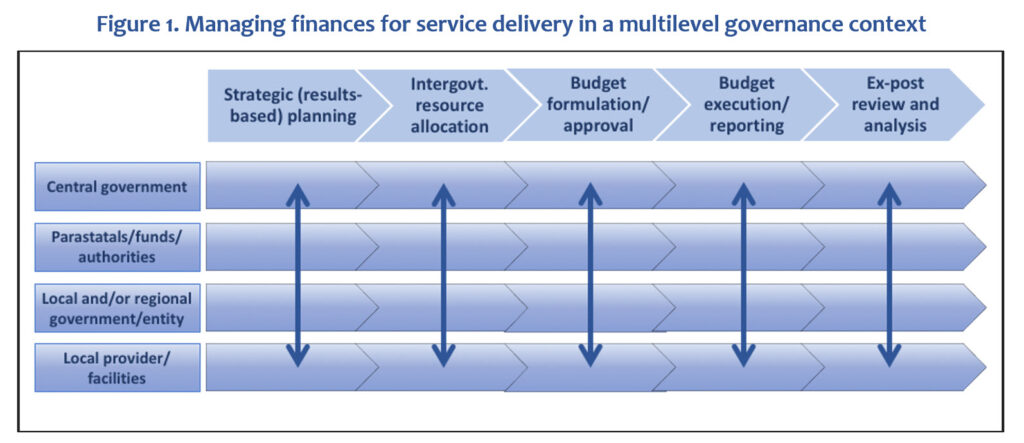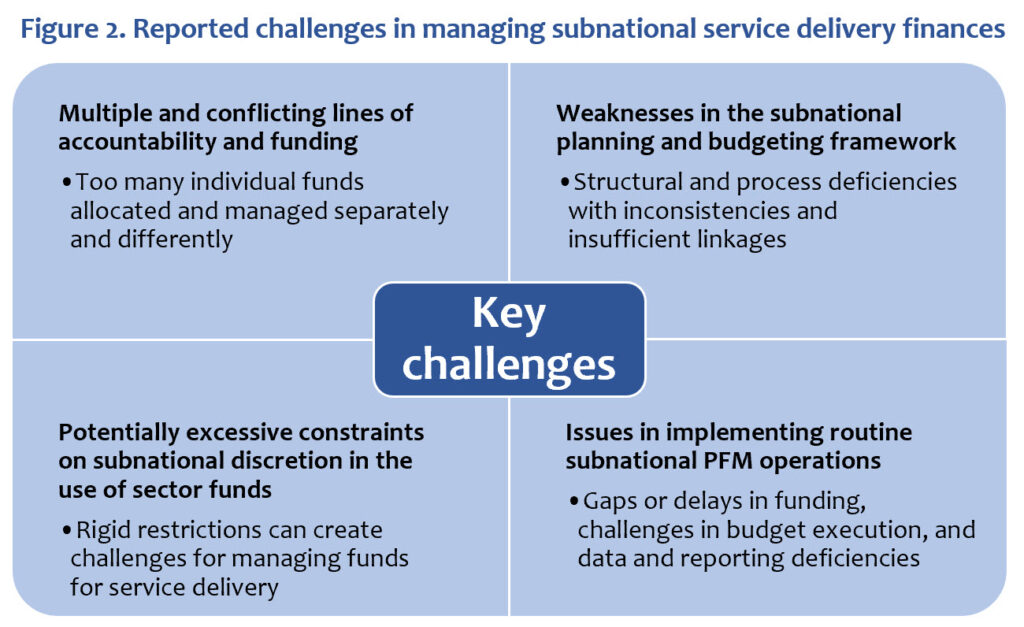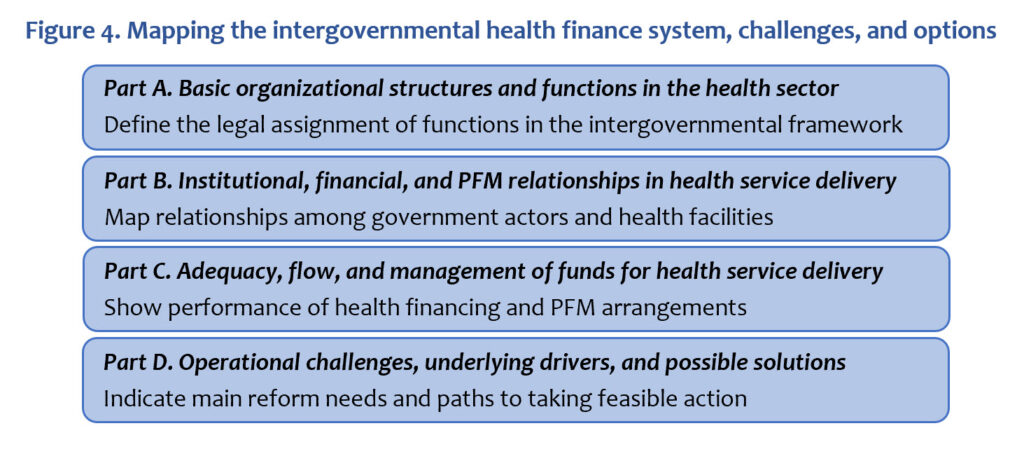
Improving service delivery is a major concern in global development agendas, but exactly how best to manage public resources to support better and more inclusive public service delivery in developing countries eludes clear guidance. Key elements of public sector operations—the sectoral policies that define service delivery parameters and resource needs; the mobilization, allocation, and management of public finances; and the roles and relationships of actors in intergovernmental systems—play vital roles in service delivery. These and other elements, however, are often developed and implemented separately.
Understanding these elements as inherently interdependent components of a complex, integrated system is essential to improve service delivery performance. Some barriers among specialists who focus on different aspects of the intergovernmental system—public financial management (PFM), service delivery, or decentralization—are beginning to break down, if somewhat tentatively and selectively. In recent years, for example, professionals in PFM and some service delivery sectors have begun to look for common ground. Yet limited attention has been directed to how sector finances are managed in diverse multilevel systems of government and how this may affect service delivery.
A recent paper for by NYU-Wagner and ODI aims to fill that gap by demonstrating how intergovernmental systems matter for service delivery and examining varied intergovernmental arrangements for health service delivery in four African countries: Ethiopia, Kenya, South Africa, and Uganda. Although some of the discussion in the paper is specific to the health sector, the basic approach is relevant for most service delivery sectors.
Managing Finances for Service Delivery in the Intergovernmental Context
Although central governments are expected to lead in defining national development policies and the systems and procedures that support their pursuit, extensive literature and experience demonstrate valuable roles for subnational governments and other local actors in managing public resources for service delivery. Moreover, decentralization has been adopted or enhanced in many developing countries, so it is a reality that must be accommodated in appropriate ways.
A complicating factor is that decentralization is highly diverse. Its arrangements range from centralized systems that manage local operations with deconcentrated field offices of national ministries to devolved systems with empowered subnational governments accountable to elected councils. Many countries have hybrid approaches that combine elements of both systems and other mechanisms (such as special agencies and parastatals), and there is great variation in the number of levels and roles of subnational government. These variations are reflected in sector policies and processes, as well as resource allocation and financial management mechanisms. A full analysis of service delivery financing therefore needs to include the intergovernmental system.
In this regard, it is important to recognize that different modes of decentralized service delivery and financing are used simultaneously, even within a given country or sector (Figure 1). The functional and financial roles of each level of government and how they interact with others involved in service delivery, including frontline service delivery facilities, must be understood to fully appreciate the system and understand how problems can be identified and remedied.
Beyond functions and finances, how PFM operates is crucial if it is to contribute to better service delivery in an intergovernmental, multi-actor context. Public finances involve all levels of government, special entities, and frontline service delivery units. Each entity manages, with varied degrees of autonomy, some aspect(s) of service delivery with mixed sources of funding, and each faces a set of institutional incentives and constraints. Not only must each actor properly manage finances according to its respective budget process, but appropriate alignment is needed among all of them to ensure the effective management of service delivery. Currently, few, if any, tools—within either the PFM, decentralization, or service delivery finance communities—are available to assess how they interact and their degree of alignment and coordination.
Challenges Facing Subnational Governments and Frontline Service Providers in Managing Finances for Service Delivery
The management of resources for public service delivery may face a wide variety of challenges. Many of them are well known, and much has been written about them, but there is less information on how these challenges play out in different intergovernmental contexts.
A mix of actors—national ministries and agencies, subnational departments, external donors—is often involved in service delivery financing and financial management.The blend and behavior of these actors can create challenges for downstream players who manage service facilities. Fragmented funding may be conditionally targeted for the same or different purposes. Without overall coordinated management of the various sources, there may be fund shortages and/or redundancies for specific categories of expenditure, even more difficult to manage if some funding sources are off budget. Moreover, even if funding sources are complementary for budgetary purposes, separate reporting channels to different fund providers may impose significant administrative burdens on subnational administrators and service delivery staff and complicate keeping proper track of resource flows.
Service delivery depends on effective development planning (for public infrastructure investment) and budgeting (both capital—for projects prioritized in development plans, and recurrent—for routine administration and operation). The case countries report issues with how plans and budgets are created and executed, and which actors are or are not involved. Weaknesses are also reported in the linkages between subnational development planning and budgeting, even if the systems are individually sound. Priority projects identified in plans might not be provided for in the capital budget, and those that are financed may not be allocated annual budget funds for operations and maintenance. Clearly such challenges can affect service delivery.
Effective service delivery depends on a suitable balance between central oversight and local discretion. The institutional and funding factors outlined in section III can enable or constrain the ability of actors at different levels—intermediate governments, local governments, frontline service delivery units—to make sufficiently independent decisions that potentially capture the potential benefits of decentralization for service delivery. National standards are legitimate, and there is no fixed rule on how much discretion subnational governments and facility managers should have—the right balance is context specific. But in all countries covered here, there were claims—at one or more levels of government or at the facility level—that a lack of autonomy hindered the effective use of resources for health service delivery.
Adequately smooth PFM operations are essential for effective and sustainable service delivery. At the most basic level, promised funding amounts should be received by subnational actors in full and on time, and this does not always occur. Once funds arrive, the budget is expected to be executed as planned within PFM guidelines. In some cases, however, total available resources or those budgeted for a specific purpose are not spent as intended at the subnational government and/or health facility level. There are common instances of insufficient adherence to expenditure management protocols and incomplete and/or delayed compliance with reporting. In addition, because off-budget funds may not be captured in official reporting, government records may not fully reflect all health funding flows—in some cases, large shares. Other elements of PFM—such as procurement, asset management, and auditing—may also suffer from delays or weaknesses in execution.
Intergovernmental Considerations in Service Delivery Financing
The elements and processes involved in financing service delivery may play out differently in different intergovernmental systems where responsibilities across levels of government vary. There are also considerable differences in the sources and mix of funding for particular services, how funds are allocated, and the precise channels and processes through which these funds flow in the national government–regional government–local government–service facility landscape. The elements and processes covered here are summarized in Figure 3.
Intergovernmental Systems and the Health Sector: Selected Country Experience
Having reviewed how intergovernmental systems may differ in terms of the sources, flow, and management of finances for service delivery, the NYU/ODI report introduces four country cases Ethiopia, Kenya, South Africa, and Uganda. It first offers a succinct overview of key country characteristics and intergovernmental systems, including assignment of functions and finances to subnational governments, the structure of subnational PFM (whether integrated into national PFM structures or separate), and other selected factors related to the role of subnational governments. Next, the report offers details on the institutional and fiscal structure of the health sector in each country. It further summarizes functional assignments, health financing sources, and how funds for health flow to subnational actors. This review is largely descriptive, comparing how the systems are set up according to legal frameworks and, where possible, when this legal guidance is not followed in practice.
Assessing Health Sector Intergovernmental Finance Challenges to Inform Solutions
In determining how to address these observed challenges in intergovernmental sector finance, it is necessary to understand what enables and generates them. This process involves two steps. The first step is to identify the factors most immediately related to specific problems—referred to here as proximate determinants. Most of them reflect flaws in the intergovernmental fiscal frameworks discussed above and /or issues in how they are implemented. The second step, therefore, involves determining the underlying causal factors that drive and sustain proximate determinants.These more fundamental—often powerful and highly durable—forces can hinder the ability of reformers to use logical remedies to address the proximate determinants in an effective and sustainable way.
A comprehensive framework assessing financial management obstacles to service delivery covers four categories of issues and concerns. The framework starts with basic information about functional assignments across government levels (A) and then moves on to the institutional and operational relationships among them (B). The third category documents service delivery funding flows and financial management arrangements (C). The last category identifies the challenges that emerged in assessing the system, the factors that shaped them, and what they imply for desired and feasible reforms (D).
–
Read the full paper:
Paul Smoke, Gundula Löffler, et al. 2021. Intergovernmental Perspective on Managing Public Finances for Service Delivery Assessing Neglected Challenges in the Health Sector and Beyond. NYU/Wagner and ODI, May 2021.








